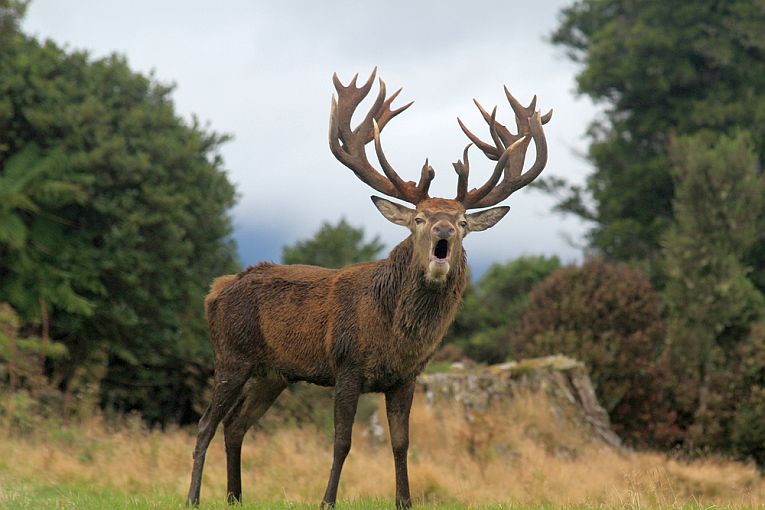In the Scottish Islands, history has been made in more ways than we can ever imagine. The red deer there can even tell a story, so to speak, of Neolithic doings, and com-ings and fro-ings! The point is that they do not come from the mainland. Alack of gene flow is seen between the island and mainland populations, partly because the treacherous straits involved would be both too cold and two swift for many animals to cross.
The document containing such valuable historic information is a paper by David W. Stanton, Jacqui A. Mulville and Michael W. Bulford of Cardiff University’s Schools of History and Biosciences. They publish, Colonization of the Scottish Islands via long-distance Neolithic transport of red deer (Cervus elephas)
in the Proc. Roy Soc B today.
Thousands of years ago, in various Stone Ages, Orkney voles were carried there, in great numbers, (about 5,000 years ago) with grass bales from unknown European sources, meat animals were carried frequently across the seas, at first in the Mediterranean and then, in the Neolithic, fur-bearing species were carried to The Isles,
and red deer were transferred from Britain to Ireland. Such interesting transports tell us a lot about these intriguing people and less about the animals concerned.
In distant times, red deer seem to have been a more domestic meat source than at present. Nobody seems to have managed to carry them as far as Iceland, northern Scandinavia or even Finland, but reindeer possibly acted as a satisfactory food source for people inhabiting some of these locations. The elk (red deer in Europe, where the elk is the well-known moose) is still widespread in Europe, partly because it is still used as a meat animal, despite being a wild species. It sheltered in warmer places(refugia) during Ice Ages and survived well afterwards, existing as 3 major distinct lineages: the eastern, the western and the Mediterranean types, with possibly some North African and Middle Eastern variations.
Hints as to the ancestry of Scottish deer, which have lived in the Inner Hebrides for 7,500 years, lie in the closeness of Norwegian Cervus genotypes, meaning that even the Norwegian mainland could have had deer transported there! The Inner Hebrides, as the name suggests, are so close to Scotland that the animals could have swum as far as 7km, according to estimates on their abilities. This puzzle is ideally situated in Scotland where both anthropogenic and natural movements can be tested, if ancient DNA (aDNA) can be found in Cervus bones.
The researchers assumed wrongly that these Hebridean red deer would have obvious links between (1) the mainland, (2) the Inner Hebrides, such as the Isle of Skye and (3) the Outer Hebrides (Western Isles,) including the Isles of Lewis and Harris. mtDNA was extracted from mitochondria in bone samples between the Mesolithic and the Norse
Ages.
Diversity of the Northern European deer sequences extracted proved a surprise. The Inner Hebrides animals had relationships with both Irish and Norwegian deer. Common haplotypes there were different from those in the Outer Hebrides, but the early haplotypes from the Mesolithic were also exclusive to that time. The plot thickens.
Diversity in the Western Isles was very high, with Orkney close behind, although all samples remained within the Western European deer type, despite most haplotypes in the outer islands being unique. One particular haplotype belongs only to ancient Norway, the modern Scottish mainland and deer hair from the clothing of an ancient friend,Oetzi the Ice Man from the Copper Age! I trust your detective skills are kicking in at this point.
The only conclusion is that all bets are off. The research produced very surprising results that are shocking for both historians and the old deer concerned. Those outer island and very diverse reds are very unlikely to have come from the British mainland, especially when we consider the inbred state of those and their neighbours on the Inner Hebrides compared to all other deer sampled. Virtually no gene flow has taken place between these island locations. No other origin can be suggested, so it is up to you. How do you think these large mammals got there, and obviously in quite big numbers?
It could be from any of our locations mentioned, if some ancient deer line has died out, as the Orcadian populations have. The long-distance sea crossing required in the Neolithic for any possible answer for us can only connect with very ancient humans carryingMegaloceros (an extinct Eurasian genus resembling the fallow deer) over short sea crossings in the Mediterranean, up to 24,000 years ago. On Oronsay and in Orkney, deer bones are very frequent in the Mesolithic diet, and later on Norse sites on Lewis and Harris. Human connections between these quite distant islands implies that the common Viking heritage (9th century) of these peoples ties in with that of the red deer, but goes far back beyond that. French and Low Country influences join those of the Norse, with many archaeological links implying religious and cultural associations. Our remarkably-diverse red deer today must be associated with these people, their feasting and even their ----burial!










